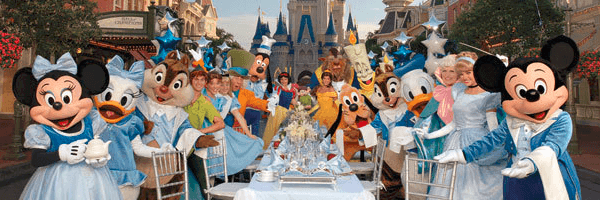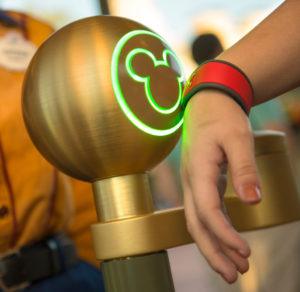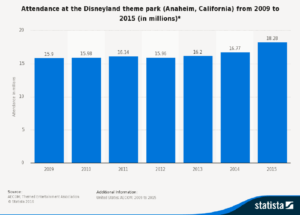Wearables and Big Data Make It a Small World After All at Disney Theme Parks

Disney theme parks offer visitors a way to completely personalize their experience, but does it result in improved revenues?
Disney theme parks are heralded for creating perfection. The parks pride themselves on cleanliness, customer experience, and making transportation as well as access easy. In 2011 Disney made a massive, billion dollar bet on technology to help facilitate this mission with the creation of the MagicBand, which debuted in 2013 [1]. A MagicBand is a rubber wristband that contains RFID technology and links to your MyMagic+ account Disney offers to make reservations for everything from food to rides. Through their use of the MagicBand, park attendees are able to make their experience personalized and seamless (MagicBands function as your passport to the park, i.e. room key, payment method, etc.). In return for this investment in technology, Disney is able to gain access to a wealth of information to improve customer service as well as park operations. But is access to this information being converted into quantifiable returns for Disney to justify its investment and does access to this data warrant the risk of potentially infringing on customer privacy?
When Disney first introduced the MagicBand, it was met with a certain amount of caution from the general public. The level of concern was actually high enough that Senator Ed Markey felt compelled to write a letter to Disney Chairman and CEO, Robert Iger, to request information about the MagicBand [2]. In his letter, Representative Markey stated that, “Although kids should have the chance to meet Mickey Mouse, this memorable meeting should not be manipulated through surreptitious use of a child’s personal information” [3]. Robert Iger’s retort stated that Disney was “offended by the ludicrous and utterly ill-informed assertion…that [Disney] would in any way haphazardly or recklessly introduce a program that manipulates children, or wantonly puts their safety at risk.” [4] Mic drop [5]. But this statement represents how serious Disney has been in its efforts to deliver its customer promise of using the MagicBand to “[provide] an even more immersive, personalized and seamless Walt Disney World Resort experience than ever before.” [6]
So how does Disney leverage this data to drive top or bottom line growth for the business? The application of the MagicBand seems to be mostly towards crowd/line management. For example, visitors are able to pre-book access to rides and various attractions. This advanced planning is also seen as a way to keep guests within the confines of the Disney property as opposed to visiting other nearby theme parks [7]. Furthermore, Disney uses the data collected to manage its workforce more efficiently. Finally, it appears that Disney has turned the MagicBands into its own business by introducing collector sets [8].
Although Thomas Staggs, Chairman of Disney Parks and Resorts, views MyMagic+ as being “transformational” to Disney’s business, it seems like Disney is relying more on fluffy returns as it tries to show ROI for the investment. It’s evident that the implementation of this device can help save costs in areas such as food preparation, staffing, etc. But how does Disney prove that because an animatronic bird addressed me by name, I ultimately spent more at the park than I otherwise would have? Yes, Disneyland theme park in California has experienced increases in attendance since the MagicBand was introduced, but there is little available data to prove attribution to the implementation of the device [9].
Regardless of financial impact, by starting down this road of technology and personalization, Disney has thrown the theme park business headlong into an arms race. Universal Orlando plans to reveal its new wearable technology, TapuTapu at the opening of its Volcano Bay park this summer [10]. The technology is aimed at making MagicBands obsolete through the addition of new features like the ability to virtually wait in line [11]. Extreme convenience and personalization appear to be becoming table stakes in the theme park business.
Given this trend, it seems like Disney is best served by expanding its use of this data towards more operational applications. One use case is optimizing refuse disposal [12]. These types of utilizations will have a more direct impact on Disney’s operating costs as the company continues to subsidize its massive spend in the name of personalization. Taking the operational approach might also help to limit the expansion of personally identifiable information linked to the MagicBands and curtail enhanced data security risks. An additional avenue that Disney could pursue would be to take its learnings from the MagicBand implementation and become a service provider for other guest experience focused industries. For example, former US Senator Bob Kerrey recently suggested that Disney help TSA fix the line length problem in US airports [13].
The digital age is, and will continue to be, a major driver of advancement for Disney’s theme park experience regardless of the company’s ability to attribute the entirety of this investment to incremental improvements in attendance or financials.
(799 words)
[1] Brooks Barnes, “At Disney Parks, a Bracelet Meant to Build Loyalty (and Sales),” The New York Times, January 7, 2013, http://www.nytimes.com/2013/01/07/business/media/at-disney-parks-a-bracelet-meant-to-build-loyalty-and-sales.html.
[2] Eben Burnham-Snyder, “Congressman Asks for Details on Data Collection, Targeting Advertisements to Children at Disney Theme Parks,” January 24, 2013, http://www.markey.senate.gov/news/press-releases/markey-to-disney-kid-tracking-bracelet-raises-privacy-questions.
[3] Eben Burnham-Snyder, “Congressman Asks for Details on Data Collection, Targeting Advertisements to Children at Disney Theme Parks,” January 24, 2013, http://www.markey.senate.gov/news/press-releases/markey-to-disney-kid-tracking-bracelet-raises-privacy-questions.
[4] http://images.politico.com/global/2013/01/30/130130_disney_markey.html, accessed November 2016.
[5] http://giphy.com/gifs/badass-mic-drop-brian-cranston-i6TQUuiT5hjSU, accessed November 2016.
[6] https://disneyworld.disney.go.com/help/privacy-legal/, accessed November 2016.
[7] Brooks Barnes, “At Disney Parks, a Bracelet Meant to Build Loyalty (and Sales),” The New York Times, January 7, 2013, http://www.nytimes.com/2013/01/07/business/media/at-disney-parks-a-bracelet-meant-to-build-loyalty-and-sales.html.
[8] http://www.magicbandcollectors.com/, accessed November 2016.
[9] https://www-statista-com.ezp-prod1.hul.harvard.edu/statistics/236154/attendance-at-the-disneyland-theme-park-california/, accessed November 2016.
[10] https://media.universalorlando.com/PressRelease/detail.aspx?id=59286&ct=27752&Src=, accessed November 2016.
[11] Rick Munarriz, “Is Disney World’s Top Rival About to Make MagicBands Obsolete?” The Motley Fool, November 5, 2016, http://www.fool.com/investing/2016/11/05/is-disney-worlds-top-rival-about-to-make-magicband.aspx.
[12] Sandra Pedicini, “Disney tries high-tech system to track trash,” Orlando Sentinel, November 4, 2016, http://www.orlandosentinel.com/travel/attractions/the-daily-disney/os-disney-world-tracking-employees-geolocation-20161104-story.html.
[13] Matthew J. Belvedere, “Let Disney fix those long TSA security lines at airports: Former Sen Bob Kerrey,” CNBC, May 18, 2016, http://www.cnbc.com/2016/05/18/let-disney-fix-those-long-tsa-security-lines-at-airports-former-sen-bob-kerrey.html.
Images (in order of appearance)
http://www.politico.com/story/2013/01/disney-strikes-back-at-markey-privacy-concerns-086828, accessed November 2016.
Brooks Barnes, “At Disney Parks, a Bracelet Meant to Build Loyalty (and Sales),” The New York Times, January 7, 2013, http://www.nytimes.com/2013/01/07/business/media/at-disney-parks-a-bracelet-meant-to-build-loyalty-and-sales.html.
https://www-statista-com.ezp-prod1.hul.harvard.edu/statistics/236154/attendance-at-the-disneyland-theme-park-california/, accessed November 2016.





It is interesting that Disney has not seen a lot of profit from the initiative even though it makes a lot of sense. Top of mind for me is managing process optimization in waiting lines through these digitized wristbands. I wonder if they can create a wristband that has an algorithm, which translates into your mobile phone telling you the most optimal route to take to wait for the least amount of time in lines. Would this be a value add where Disney can charge for the service from the app? This is more looking at this from a revenue maximization perspective rather than the cost-saving perspective that you mentioned in your article.
Great article, John Smith. I actually worked for Disney back in 2012, and they were just on the verge of rolling this out within the next year. There was definitely great buzz, and excitement. However, I remember one of the concerns was that with the program, it was going to limit opportunities for “magical moments”, which basically were opportunities where cast members (i.e., employees within the parks) would be able to deliver customer service over and above expectation to make someone’s day. For example, if a kid lost his fast past card while in line, and got to the front, the cast member had the latitude to say, “don’t worry, this one’s on me”. Do you think this is a justified concern?
Great article, John Smith! I actually wrote about the same thing but from a different angle, so it was especially interesting to hear your take. I understand that privacy was a big concern when the Magic Band launched, but do you think Disney adequately assuaged fears by creating a menu of opt-in options for parents? For example, when the parent activates the band, he/she has the option to choose what information is shared, including names, ages, etc. Do you think this is enough or is there still a lot of upset/unrest about data safety and privacy?
Secondly, how do you think the proliferation of mobile will affect this program in the future? It seems Disney Shanghai bypassed the magic band altogether and relies solely on the mobile platform. Do you think this passes up an important opportunity given that not all children have mobile phones or do you think this streamlines the digitization and makes integration more likely?
Thanks for the fascinating post! I had no idea that theme parks were rolling out this type of technology, and I could see how it would make the customer experience so much more seamless. I can only imagine the time saved in line, and the convenience of never having to dig in your pocket to get your hotel key or pay for a ride. Intuitively, it makes sense that this could help grow revenues, as people would be more likely to pay for things simply due to convenience as well as the fact that paying from a wristband doesn’t feel as mentally taxing as pulling cash out of your wallet. And, because of better flow of logistics, they can help people reach more rides in less time.